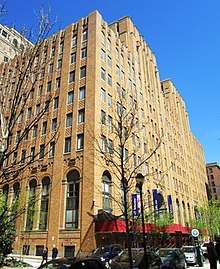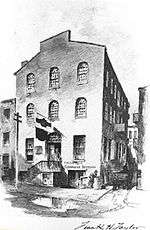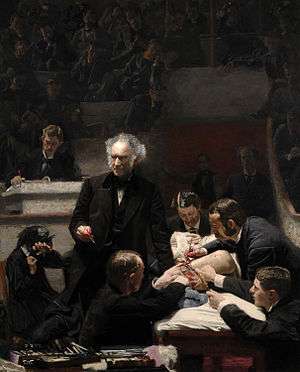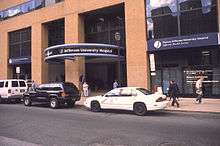Thomas Jefferson University
 Overview of Thomas Jefferson University | |
Other name | Philadelphia University + Thomas Jefferson University |
|---|---|
| Type | Private |
| Established |
1825 (founded 1824)[1] |
Parent institution | Thomas Jefferson University Hospitals Inc. |
| Affiliation | Jefferson Health |
| Endowment | $614.3 million[2] |
| Chairman | Stephen P. Crane |
| Chancellor | Stephen Spinelli Jr, Ph.D. |
| President | Stephen K. Klasko, MD, MBA |
| Provost | Mark Tykocinski, MD |
| Students | 2,867[3] |
| Undergraduates | 1,057[3] |
| Postgraduates | 844[3] |
| Location |
Philadelphia, PA, USA 39°56′54″N 75°09′24″W / 39.9484°N 75.1567°WCoordinates: 39°56′54″N 75°09′24″W / 39.9484°N 75.1567°W |
| Campus | Urban |
| Nickname | Rams |
Sporting affiliations | NCAA Division II |
| Website |
www |
 | |
Thomas Jefferson University is a private university in Center City, Philadelphia, Pennsylvania, United States. The university consists of six constituent colleges and schools: Sidney Kimmel Medical College, College of Architecture & The Build Environment, Jefferson College of Biomedical Sciences, Jefferson College of Health Professions, Jefferson College of Nursing, Jefferson College of Pharmacy, and Jefferson College of Population Health.
History

Although today Thomas Jefferson University includes many different graduate programs, it began as a medical school. During the early 19th century, several attempts to create a second medical school in Philadelphia had been stymied, largely due to the efforts of University of Pennsylvania School of Medicine alumni.[1][4] In an attempt to circumvent that opposition, a group of Philadelphia physicians led by George McClellan sent a letter to the trustees of Jefferson College in Canonsburg, Pennsylvania (now Washington & Jefferson College) in 1824, asking the College to establish a medical department in Philadelphia.[5] The trustees agreed, establishing the Medical Department of Jefferson College in Philadelphia in 1825.[1][5] In response to a second request, the Pennsylvania General Assembly granted an expansion of Jefferson College's charter in 1826, endorsing the creation of the new department and allowing it to grant medical degrees.[1][5][6] An additional 10 Jefferson College trustees, including Joel Barlow Sutherland, were appointed to supervise the new facility from Philadelphia, owing to the difficulty of managing a medical department on the other side of the state.[5] Two years later, this second board was granted authority to manage the Medical Department, while the Jefferson College trustees maintained veto power for major decisions.[5]
The first class was graduated in 1826, receiving their degrees only after the disposition of a lawsuit seeking to close the school.[5] The first classes were held in the Tivoli Theater on Prune Street in Philadelphia, which had the first medical clinic attached to a medical school.[7] Owing to the teaching philosophy of Dr. McClellan, classes focused on clinical practice.[7] In 1828, the Medical Department moved to the Ely Building, which allowed for a large lecture space and the "Pit," a 700-seat amphitheater to allow students to view surgeries.[7] This building had an attached hospital, the second such medical school/hospital arrangement in the nation, servicing 441 inpatients and 4,659 outpatients in its first year of operation.[7] The relationship with Jefferson College survived until 1838, when the Medical Department received a separate charter, allowing it operate separately as the Jefferson Medical College.[6][8] At this time, all instructors, including McClellan, were vacated from the school and the trustees hired all new individuals to teach. This has been considered the time at which the school came to be considered a "legitimate" medical school.[1][9]
In 1841, Jefferson Medical College hired what would be dubbed "The Faculty of '41", an influential collection of professors including Charles Delucena Meigs and Mütter Museum founder Thomas Dent Mütter. This collection of professors would institute numerous impactful changes to Jefferson—including Jefferson providing patient beds over a shop at 10th and Sansom Streets in 1844—and the staff would remain unchanged for fifteen years.[10] The graduating class of 1849 included Charles Sutherland, the son Joel Barlow Sutherland, who went on to serve as Surgeon General of the United States Army.[11]
A 125-bed hospital, one of the first in the nation affiliated with a medical school, opened in 1877, and a school for nurses began in 1891. The Medical College became Thomas Jefferson University on July 1, 1969. As an academic health care center, Jefferson is currently involved in education, medical research, and patient care. Jefferson Medical College is the 9th oldest American medical school that is in existence today.[12]

In January 2007, the university sold Thomas Eakins' painting The Gross Clinic, which depicts a surgery that took place at the school, for $68 million, to the Pennsylvania Academy of the Fine Arts, in association with the Philadelphia Museum of Art.[13] A reproduction hangs in its place at Jefferson University.
On June 17, 2014, Sidney Kimmel donated $110 million to Jefferson Medical College, prompting the announcement that Jefferson Medical College would be renamed Sidney Kimmel Medical College [14]
In May 2017, the university officially announced that it will be merging with Philadelphia University. The combined institution will retain the Thomas Jefferson University name.[15]
Affiliations

The University is affiliated with Thomas Jefferson University Hospitals (TJUH)—including Thomas Jefferson University Hospital, Jefferson Hospital for Neuroscience, and Methodist Hospital.
Thomas Jefferson University is also the primary academic affiliate of the Jefferson Health System. Jefferson Health System was founded in 1995 when Thomas Jefferson University Hospital and the Main Line Health System signed an agreement establishing a new, nonprofit, corporate entity known as the Jefferson Health System. The agreement brought together the Thomas Jefferson University Hospitals, Inc. and Main Line Health under one corporate parent. Since then, other established networks have joined Jefferson Health System as founding members, which at one point included the Albert Einstein Healthcare Network,[16] Frankford Health Care System (now Aria Health),[17][18] Main Line Health and Magee Rehabilitation Hospital.
On June 20, 2013 the board of directors for both organizations announced that Stephen Klasko would assume the role of President and CEO for both Thomas Jefferson University and the TJUH System in an effort to unify the clinical and educational missions on campus. In March 2014, the Jefferson Health System was dissolved "in order for (TJUH) to move forward" and "be nimble and agile, but also not be constrained by a corporate relationship that in some respects put some limits on what we could do," according to Klasko.[19]
See also


- Philadelphia University
- Thomas Jefferson University alumni
- Medical schools in Pennsylvania
References
- 1 2 3 4 5 Gayley, James Fyfe (1858). A history of the Jefferson Medical College of Philadelphia. Philadelphia: Joseph M. Wilson.
- ↑ "College and University Endowments Over $250-Million, 2007". Chronicle of Higher Education. August 29, 2008. p. 28.
- 1 2 3 Jefferson Fall 2006 Overview, College Toolkit.
- ↑ "George McClellan, Founder". A Brief History of Thomas Jefferson University. Thomas Jefferson University. Retrieved 2010-04-13.
- 1 2 3 4 5 6 Pedrick, Alexander K. (1898). "The Jefferson Medical College of Philadelphia". Charitable Institutions of Pennsylvania. 1. State Printer of Pennsylvania. pp. 177–202.
- 1 2 "Establishing a School". A Brief History of Thomas Jefferson University. Thomas Jefferson University. Retrieved 2010-04-13.
- 1 2 3 4 "Early Homes". A Brief History of Thomas Jefferson University. Thomas Jefferson University. Retrieved 2010-04-13.
- ↑ Medical Society of the State of Pennsylvania, ed. (September 1915). "Jefferson Medical College". The Pennsylvania Medical Journal. 18. p. 950.
- ↑ Morton, Samuel George (1849).

- ↑ Aptowicz, Cristin (September 2014). Dr Mutter's Marvels: A True Tale of Intrigue and Innovation at the Dawn of Modern Medicine. New York: Avery Books. p. 83. ISBN 978-1-592-40925-9.
- ↑ Pilcher, James Evelyn (1905). The Surgeon Generals of the Army of the United States of America. Carlisle, PA: Association of Military Surgeons of the United States. p. 79.
- ↑ "Essay::Health Sciences Library". Upstate.edu. Archived from the original on October 6, 2008. Retrieved April 30, 2013.
- ↑ Michael Kimmelman (January 12, 2007). "In the Company of Eakins". The New York Times.
- ↑ "Kimmel donates $110M to Jefferson". philly-archives.
- ↑ Lattanzio, Vince (May 5, 2017). "Philadelphia University Will Be Renamed Thomas Jefferson University When Merger Complete". NBC 10. Retrieved July 19, 2017.
- ↑ "Jefferson Health System - News archives". Jeffersonhealth.org. Archived from the original on December 3, 2012. Retrieved April 30, 2013.
- ↑ "Jefferson Health System - JHS and Frankford Health Care System Complete Realignment". Jeffersonhealth.org. December 31, 2008. Archived from the original on March 31, 2012. Retrieved April 30, 2013.
- ↑ "Aria Health History – Frankford Section of Philadelphia". Ariahealth.org. Retrieved 2013-04-30.
- ↑ "Jefferson, Main Line Health split their financial partnership". philly-archives.
External links
| Wikimedia Commons has media related to Thomas Jefferson University. |
- Official website
- Additional primary resources from the Jefferson History Collections from the Scott Memorial Library, Thomas Jefferson University